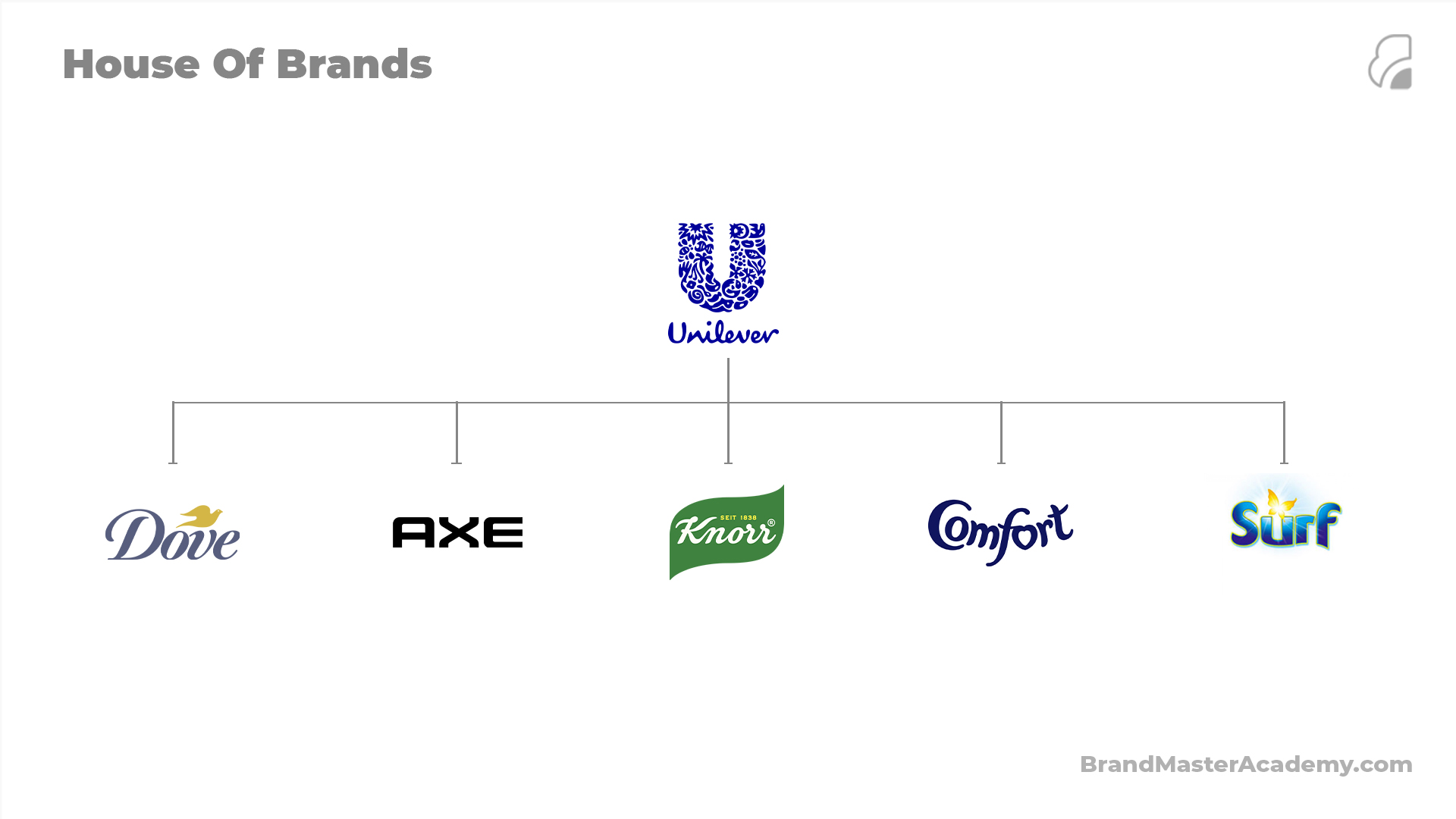Branding is about clarity both internally and externally.
One of the most effective vehicles for clarity is brand architecture and one of the most effective structures is the house of brands.
The house of brands strategy provides larger companies with the ability to manage a portfolio of bands with flexibility and independence to expand across markets.
If you want to know exactly what a house of brands strategy is, the pros and cons are and the best house of brand examples across markets, this article will break it down for you.
What is House of Brands Strategy

A 'House of Brands' is a strategy where a company owns multiple brands that operate independently and target different market segments.
Each brand under the 'house' has its own identity, values, and target audience, distinct from the parent company and other brands within the endorsed brand portfolio.
This strategy allows companies to cater to diverse customer needs and preferences, creating a broad market and strong brand presence.
PRO Brand Strategy BluePrint
Build Brands Like A Pro Brand Strategist

Pros of House of Brands

The House of Brands strategy offers plenty of advantages. It allows for market segmentation and brand extensions, with each brand catering to a specific demographic or consumer need.
It also provides a buffer against risks, as a crisis in one brand does not directly impact on all the brands of others.
Furthermore, it enables companies to experiment with new products or markets without diluting the identity or reputation of their existing brands.
Cons of House of Brands

However, the House of Brands strategy also has its challenges. It can be complex and costly to manage multiple brands, each with its own marketing strategy, product development, and operational requirements.
There's also the risk of market cannibalization, where brands within the same portfolio compete against each other.
When to Choose House of Brands?

A House of Brands strategy is ideal for companies that operate in diverse markets endorsing brands or industries, where each brand needs to have its own distinct identity and positioning.
It's also suitable for companies that acquire other businesses, allowing them to maintain the acquired brand's identity and customer base.
Explore Brand Strategy
Programs & Tools
5 Top Examples of House of Brands
Unilever

Unilever is a prime example of a successful House of Brands.
This multinational company owns over 400 brands, each with its own identity and target market.
Some of the well-known brands under Unilever's umbrella include
Dove: A personal care brand known for its moisturizing products and body-positive messaging.
Axe: A men's grooming brand with a youthful, edgy image.
Ben & Jerry's: A premium ice cream brand known for its creative flavors and commitment to social causes.
Procter & Gamble (P&G)

P&G is another global company that operates as a House of Brands. It owns a diverse portfolio of brands across various consumer goods sectors.
Tide: A leading laundry detergent brand known for its cleaning power.
Pampers: A top-selling brand of baby diapers recognized for its comfort and quality.
Gillette: A renowned brand in the men's grooming sector, famous for its razors and shaving products.
Estée Lauder Companies

In the beauty and cosmetics industry, Estée Lauder Companies stands out with its House of Brands strategy.
It owns multiple brands, each catering to different segments of the beauty market.
MAC: A professional-grade makeup brand popular among makeup artists and enthusiasts.
Clinique: A skincare brand known for its dermatologist-developed, allergy-tested products.
Tom Ford: A luxury brand offering high-end cosmetics, fragrances, and accessories.
PepsiCo

PepsiCo's portfolio goes beyond its eponymous cola brand.
It owns a variety of beverage and snack brands, each with its own distinct identity.
Gatorade: A sports drink brand, targets athletes and fitness enthusiasts.
Lay's: A snack brand, appeals to a broad audience with its wide range of potato chip flavors.
Tropicana: A juice brand, is known for its 100% pure and natural orange juice.
Volkswagen Group

In the automotive industry, Volkswagen Group operates a successful House of Brands.
It owns several car brands, each targeting different segments of the auto market.
Volkswagen: Targets the mass market with its reliable, affordable vehicles.
Audi: Offers premium vehicles known for their luxury and performance.
Lamborghini: Caters to the high-end market with its exotic sports cars.
How to Apply House of Brands?

Implementing a House of Brands strategy involves careful planning and execution across numerous brands.
It starts with a clear understanding of your target markets and how each brand will cater to a specific segment.
Each brand should have its own identity, values, and marketing strategy.
It's also crucial to have distinct brand voices and establish clear boundaries between brands to avoid market confusion or cannibalization.
Enable Customer Loyalty with the Appropriate Platform (For House of Brand)

Customer loyalty is key in a House of Brands strategy.
This can be achieved through a combination of high-quality products, excellent customer service, and loyalty programs that reward repeat customers.
The choice of platform for these programs should align with the primary brand name's target audience and digital strategy.
Other Types of Brand Architectures

Apart from the House of Brands model, there are other types of brand architectures, such as the
Branded House: Where all products or professional services share the same brand name.
The Endorsed Brand model: Where sub-brands are endorsed by the parent brand, similar to the branded house model with more independence.
The Hybrid model: A combination of different models.
Understand Your Audience to Drive Growth

Understanding your audience is crucial in any effective brand strategy.
It allows you to tailor your company's products, marketing efforts, and customer experience to meet their needs and preferences, driving growth and customer loyalty.
Over To You
In conclusion, the House of Brands strategy offers a powerful way for companies to diversify their portfolio and cater to a wide range of market segments.
However, it requires careful planning and management to ensure each brand maintains its very own unique identity and value proposition.
By understanding your audience and aligning your master brand strategy with the right digital commerce model, you can leverage the House of Brands to drive growth and success in the modern marketplace.
FAQs
1. What is a house of brands?
A house of brands is a strategy where a company owns multiple brands that operate independently and target different market segments.
2. What are the best House of brands examples?
Some successful examples include Unilever, Procter & Gamble, and Estée Lauder Companies.
3. How does House of brands work?
Each brand under the 'house' has its own identity, values, and target audience, distinct from brands operated by the parent company and other brands within the portfolio.
4. What is the difference between endorsed brands and House of brands?
Endorsed brands are sub-brands that are linked to the parent brand, while in a House of Brands, each sub brand often operates independently.
5. What is House of brands in marketing?
In marketing, a House of Brands refers to a strategy where a company markets multiple brands, each with its own brand identity and target audience.
On-Demand Digital Program
Brand Master Secrets
Make the transition from hired-gun to highly valued brand strategist in less than 30 days. The systems, frameworks and tools inside this comprehensive program are all you need to level up.







